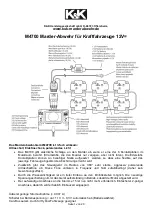
184
In Case of Emergency
Do not push or tow your vehicle
to start it. Under some conditions
this may damage the three-way
catalytic converter or other parts
of the vehicle.
If your vehicle has a discharged
battery, it can be started by using
the battery in another vehicle; a
procedure called “jump starting.”
A battery can explode if you
do not follow the correct
procedure, seriously injuring
anyone nearby.
Keep all sparks, open flames,
and smoking materials away
from the battery.
To jump start your vehicle:
1. Position the vehicle with the
good (charged) battery so that
the jump-starting cables will
reach. Do not allow the vehicles
to touch. Check to see that the
bumpers do not touch.
2. Turn off all electric motors
and accessories in both
vehicles. Turn off all lights
except hazard flashers and
lights needed to light up the
work area. Turn off the
ignition, apply the parking
brake firmly, and shift an
automatic transmission to
“P” (Park) and a manual
transmission to “N” (Neutral)
in both vehicles.
3. Check fluid level of the
battery before attempting to
charge or jump start. (Do not
use an open flame to check,
and do not smoke.)
CHARGE
TEST
INDICATOR
UPPER
LEVEL
LOWER
LEVEL
CHARGING
NECESSARY
OK
BLUE
COLORLESS
If the battery is a sealed type
and if the fluid level is below
the lower level line on the side
of the battery, do not try to
jump start the vehicle or
charge or test the battery. Do
not add fluid. Instead, install a
new battery.
Jump Starting
















































